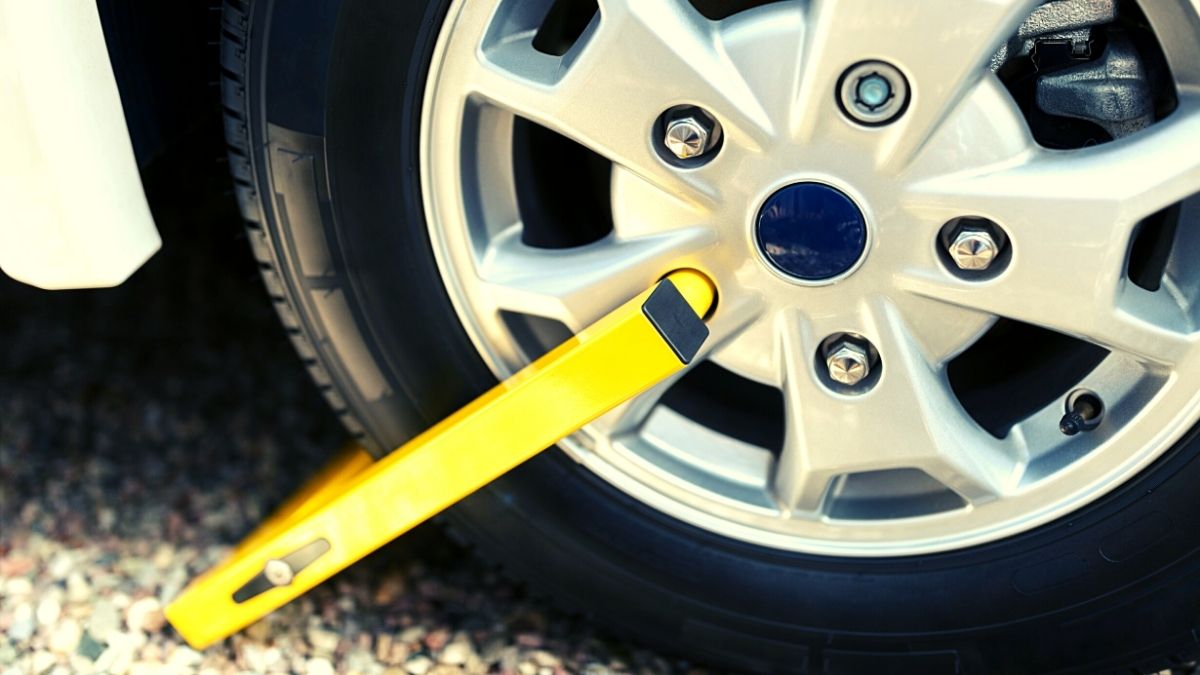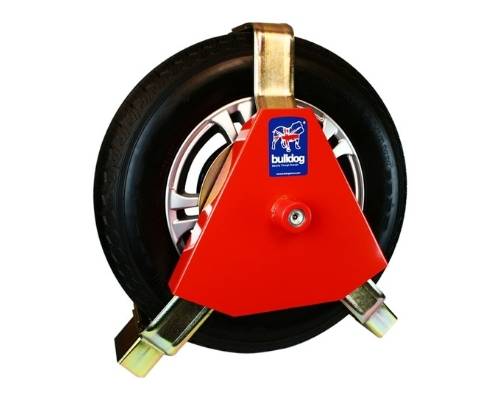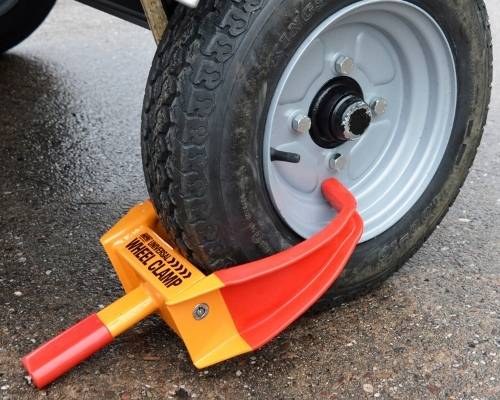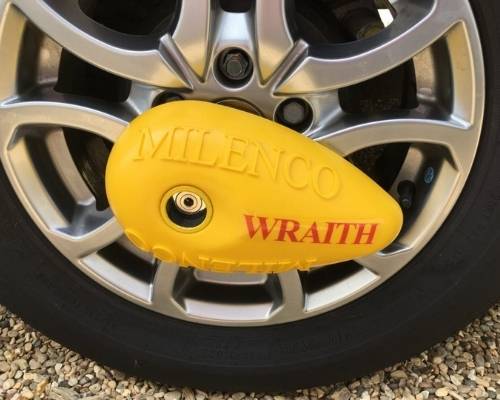Motorhome wheel clamps are becoming an essential security accessory. They are a very visible anti-theft device and should cause most would-be thieves to walk away and look for an easier target.
Wheel clamps, also known as wheel locks, wheel boots, or parking boots, are similar to the clamps used by council traffic wardens and parking inspectors to immobilise delinquent cars. Motorhome wheel clamps can also be used on campervans, cars, caravans, and trailers, depending on their wheel sizes.
In this guide, we’ll show you how a wheel clamp works, the benefits and features of various styles of motorhome wheel clamps and wheel locks, and how to fit a wheel clamp on your motorhome or campervan.
How do wheel clamps work?
Wheel clamps work by immobilising the vehicle with a physical impediment that stops the wheel from rotating. The vehicle can’t be driven, pushed, or towed away with one wheel immobilised, even when the thief has the ignition key.
Wheel clamps are excellent security devices. They are very effective physical immobilisers and are a highly visible deterrent.
Many motorhome thieves will simply move on when they see a clamp in place.
Wheel clamps provide you with peace of mind at a relatively low cost. Once you know how it’s done, they are very quick to fit.
A wheel clamp won’t stop a vehicle from being crane-lifted onto a trailer by more determined (and organised) thieves. It is possible to remove wheel clamps but only with specialist power tools and a lot of noise and time.
Security tip: keep your wheel clamp keys separate from your motorhome ignition key. This way, if a thief steals your keys they still won’t be able to unlock the wheel clamp.
Insurance requirements for motorhomes
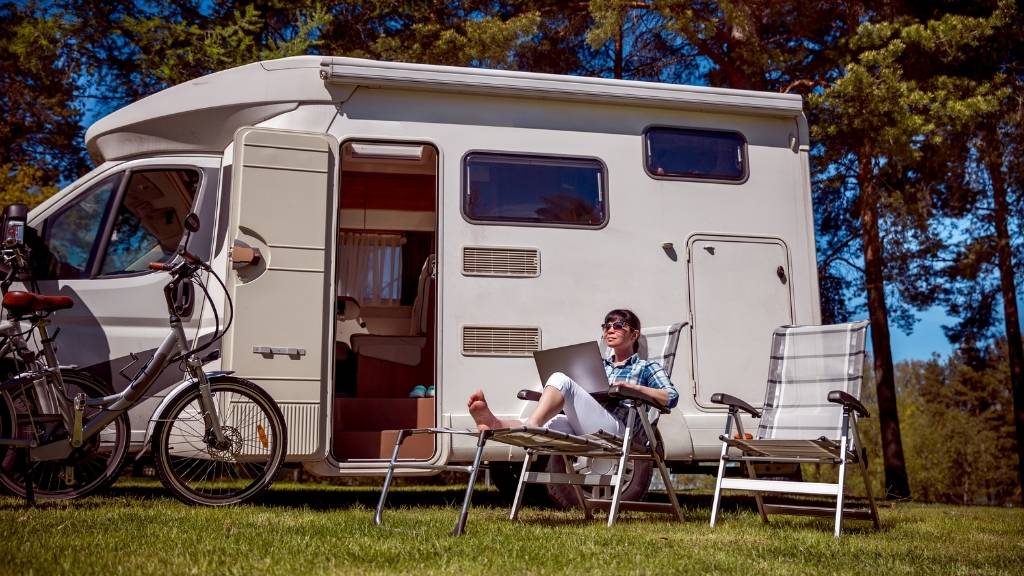
Checking with your insurance company is an essential part of your approach to motorhome security.
Some motorhome insurance policies will require an approved wheel clamp to be fitted whenever your motorhome is unattended. Caravan insurance policies typically require a wheel clamp and/or a hitch lock to be in place.
Insurance Tip: It is essential that you have the security devices fitted that are required by your insurer. Without them, at best you could pay a higher excess. At worst you may not be paid out for the loss at all.
What are insurance-approved wheel clamps?
Insurance companies will usually refer to “approved” security devices. These have been tested and certified by independent organisations.
The main UK-based independent agencies for automotive security products are Sold Secure and Thatcham. Some devices are also accredited by European bodies such as TUV and SCM.
What is the best type of wheel clamp for a motorhome?
There are a lot of wheel clamping devices on the market. Therefore it is helpful to understand some of the differences. This way you can select something suitable for your motorhome or campervan.
Some manufacturers make wheel clamps specifically for motorhomes. Always check the product description carefully to check that the model you are considering is suitable for your vehicle. Crucially this includes wheel size requirements (see below).
There are various wheel clamp styles and types, including:
Triangle wheel clamps
Triangular wheel clamps are similar to the familiar style favoured by police and traffic wardens.
They have chains or metal arms which wrap firmly around the tyre, often have metal chocks at the front and back of the wheel, and a locked triangular covering plate over the wheel nuts.
Pros: Triangular or pyramid wheel clamps have the benefit of high visibility and are immediately recognisable as a serious impediment to theft.
Cons: They tend to be quite heavy and larger to carry than other styles, and can be fiddly to put on.
Claw-style wheel clamps
These wheel clamps have two parallel metal arms that fit around the inside and outside of the wheel at a single point, with a metal wheel chock or steel post to stop the wheel from turning.
Pros: They are more straightforward to fit on the vehicle and are not as heavy as triangular clamps.
Cons: Claw-style wheel clamps are still a lumpy, heavy item to store and carry, particularly in a campervan with limited storage space. Some cheaper models are not security-approved and easy to defeat.
Limpet-style wheel locks
Limpet-style wheel clamps are designed primarily for caravans and trailers. Some motorhomes and campervans that have a suitable wheel design may also be able to use them.
Rather than going around the tyre, this style of clamp is bolted to one of the wheel bolts with a special wheel nut fitting.
A long steel pole is inserted through one of the gaps in the wheel rim pattern. This goes right through the wheel to a position underneath the chassis.
Pros: They are very secure as the important components sit within the wheel structure, are very easy to fit once set up, and are more compact for carrying when travelling.
Cons: As they are aimed at caravans, limpet-style wheel locks will only suit certain other vehicles with visible wheel nuts (ie, no hubcaps or bolt covers), and a wheel design that allows the steel pole to be inserted through the wheel.
Other styles of wheel clamp
There are numerous variations of these three styles. This includes wheel clamps designed for twin-axle motorhomes and caravans. They all have the same effect – make the vehicle impossible to move on its wheels.
What size wheel clamp do I need?
Motorhome wheels are generally larger than the average car wheel, so some wheel clamp models will not fit motorhome wheels.
Look for the manufacturer’s information to see if a particular wheel clamp model is suitable for your vehicle.
Wheel clamp size requirements are usually expressed as a range of tyre widths and wheel diameters. Always check that your motorhome or campervan wheel dimensions are within the stated size ranges.
How to measure wheel size
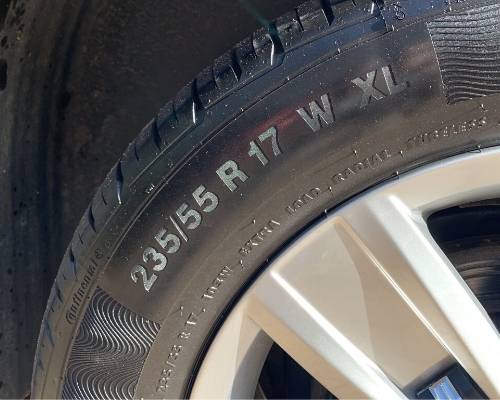
To measure your van’s wheel size, firstly look at the details printed on the sidewall of one of the tyres. The dimensions you need are shown in three parts:
aaa/bb R cc
These numbers are, rather confusingly, each in a different unit of measurement.
- aaa = tyre width in millimetres
- bb = tyre profile (sidewall height) as a percentage of tyre width
- cc = wheel rim diameter in inches (the R simply means radial type)
| Let’s take an example of a VW California campervan with tyre markings showing 235/55 R 17. This means a tyre width of 235mm, tyre profile of 55%, and wheel rim diameter of 17 inches. The R simply means radial tyres. |
Depending on the particular wheel clamp, it may specify both wheel width and total wheel diameter, or just total wheel diameter.
What is the total wheel diameter?
The “total wheel diameter” is the diameter of the entire wheel including tyre, measured in millimetres.
A measuring tape from top to bottom (or side to side) will get you a close result, but the more accurate method is using the printed tyre dimensions. The formula is:
Total Wheel Diameter (TWD) calculation
TWD = (tyre width (mm) x profile (%) x 2) + (wheel rim diameter (inches) x 25.4)
TWD = (aaa x bb x 2) + (cc x 25.4)
| In our VW California example: TWD = (235 x 55% x 2) + (17 x 25.4) = 690.3 mm. Our VW campervan therefore needs a wheel clamp that fits a tyre width of 235mm and a total wheel diameter of 690mm. |
How to put on a wheel clamp

The method for fitting a wheel clamp on to your motorhome depends entirely on the design of the device.
For triangular wheel clamps, this involves placing the clamp arms or chains around the tyre at two or three points, tightening the whole assembly so it fits firmly around the tyre, and locking the cover plate in place with a key. Inserting the arm pieces and getting them around the tyre can be awkward, particularly at the top near the wheel arch.
Claw-style clamps are a bit more straightforward as they go behind and in front of the tyre at just one point, before tightening and locking the clamp. Some claw-style models are locked to a wheel nut, and some just fit inside the wheel rim. Like triangular clamps, the arms need to fit firmly around the tyre so they can’t be moved easily.
Limpet-style clamps must be set up in advance, as they require replacing a wheel nut with a special receiving bolt. However, they are easy to fit once the initial setup is done. Slide the steel pole on to the main assembly, insert it through the wheel, line up the limpet with the bolt receiver, and turn the key.
Note for caravans: Some wheel locks are designed to be inserted into a pre-installed receiving point on caravans and trailers next to the brake drum. These are very secure devices but can be awkward when fitting to line up with the receiving point.
Conclusion: get a wheel clamp
A wheel clamp for your motorhome or campervan is a relatively inexpensive item to help secure your expensive leisure vehicle.
Deciding what to buy depends on how you use and store your van, insurance requirements, other security in place, your carrying capacity, and personal preference.
For most motorhome owners, a wheel clamp is peace of mind worth having.
Further reading: Campervan Security: The Ultimate Guide
